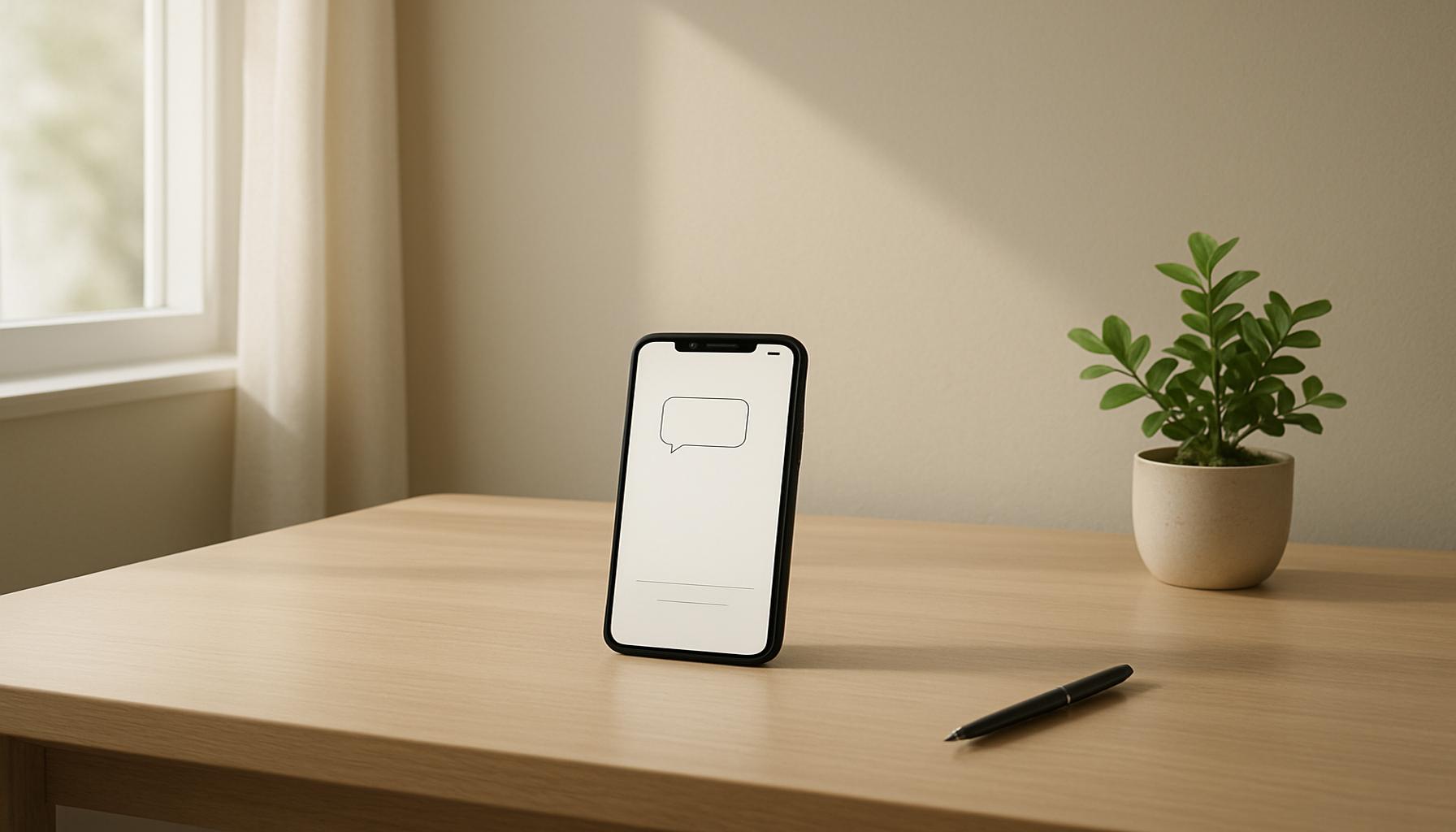Minimalism in Communication: Reducing Noise to Increase Clarity and Concentration

Understanding the Importance of Minimalist Communication
In today’s fast-paced digital environment, where smartphones alert us every few minutes and social media bubbles with notifications, the challenge of communicating effectively cannot be overstated. Individuals and organizations alike grapple with the overwhelming volume of information, often leading to misunderstandings and diminished communication effectiveness. In this context, a minimalist approach to communication emerges as a viable solution that can significantly enhance understanding and interaction.
Concise Messaging
When it comes to concise messaging, less truly can be more. Crafting messages that distill thoughts down to their essence allows receivers to engage quickly and without cognitive overload. For example, consider a scenario in a corporate environment: a manager may need to convey project updates. Rather than inundating the team with lengthy emails, a brief bullet-point summary could effectively highlight the key takeaways. This approach not only respects the recipients’ time but also enhances the likelihood of retention, ensuring that crucial details are not lost in a sea of words.
Intentional Platforms
The selection of intentional platforms one uses for communication is also vital. Different messaging tools serve different purposes. For deeper discussions or detailed reports, emails are ideal due to the capacity for well-structured content. Conversely, instant messaging applications, like Slack or Microsoft Teams, work better for real-time, quick questions or casual updates. However, recognizing when to switch mediums can make a significant difference. For instance, shifting a complex issue discussed on text to a video call can provide deeper insights and foster collaborative problem-solving.
Active Listening
Finally, the practice of active listening is an indispensable element of efficient communication. This technique involves genuinely focusing on the speaker, understanding their messages, and responding thoughtfully. By fostering true dialogue, it reduces the necessity for clarifications and backtracking caused by miscommunications. In personal settings, this might manifest as a parent fully engaging in a child’s story, whereas professionally, it entails leaders providing dedicated time to listen to colleagues’ ideas without distractions.
Implementing these minimalist strategies not only enhances concentration but also cultivates more profound relationships, whether personal or professional. By eliminating the noise that complicates our everyday exchanges, we pave the way for more insightful discussions, leading to improved teamwork and creativity. In a world that often feels chaotic, the exploration of minimalist communication may hold the key to clarity and connection, inviting us to rethink how we interact within both our immediate environments and the broader scope of society.

DIVE DEEPER: Click here to discover the tranquility of minimalism
Strategies for Embracing Minimalist Communication
To effectively adopt a minimalist approach in communication, it’s essential to explore specific strategies that can minimize distraction and maximize clarity. These approaches can empower individuals and organizations alike to streamline their exchanges while preserving the essential message. Here are several key strategies to consider:
Clarity Through Simplicity
The cornerstone of minimalist communication lies in achieving clarity through simplicity. This entails not just the brevity of messages but also ensuring that the language used is straightforward and devoid of jargon. A common pitfall in corporate communication is the overuse of complex terminology that may alienate or confuse the audience. For instance, instead of saying, “We will implement optimization protocols to enhance efficiency,” one might say, “We will simplify our processes to work better.” Such clarity lends itself to better understanding and easily digestible information, reinforcing the importance of simplicity in spoken and written communication.
Utilizing Visual Aids
Incorporating visual aids into communication can dramatically reduce cognitive load and enhance retention. Visuals, such as charts, graphs, infographics, and even simple bullet points, can encapsulate large amounts of information succinctly. According to research by the Social Science Research Network, incorporating visuals can improve comprehension by up to 400%. By transforming complex data into easily viewable formats, the audience can more readily grasp and recall essential concepts. Furthermore, utilizing visuals in presentations or reports allows the speaker to elaborate verbally without drowning the audience in excessive text.
Establishing Communication Norms
Encouraging communication norms within an organization can foster a culture of clarity and focus. This may involve implementing practices such as:
- Avoiding unnecessary emails: Establish guidelines on what warrants an email versus an instant message or face-to-face discussion.
- Structured meeting agendas: Create clear objectives and time limits for meetings, ensuring only relevant topics are discussed.
- Regular feedback loops: Encourage team members to share their thoughts on what communication methods are working well and what could improve.
By collectively deciding on communication practices, teams can establish a shared understanding that leads to enhanced efficiency and encourages individuals to be more mindful of how they convey information.
As the noise surrounding our digital communications continues to grow, implementing minimalist communication strategies offers a path toward increased clarity and concentration. By reflecting on clarity, simplifying language, utilizing visual aids, and reinforcing behavioral norms, both individuals and organizations can significantly ameliorate their communicative effectiveness. In an age where distraction is an ever-present challenge, these minimalist techniques provide a refreshing and transformative approach that not only enhances personal engagement but also contributes to a more connected and harmonious environment.
Exploring the Dimensions of Minimalism in Communication
In the fast-paced world we inhabit, the bombardment of information often leads to cognitive overload. Embracing a minimalistic approach in communication not only fosters clarity but significantly enhances concentration. By stripping communication to its essentials, individuals and organizations can foster more productive interactions. One of the vital aspects of minimalism in communication is the concept of intentional messaging. Every word, gesture, or symbol used carries weight. Therefore, consciously selecting what to convey cultivates a more meaningful exchange of ideas. This practice encourages individuals to reflect on their messages, ensuring that each point resonates with clarity rather than being lost in the noise of superfluous details.Additionally, minimizing distractions enhances focus. Environments laden with visual chaos or auditory pollution sabotage our ability to absorb and process information effectively. Implementing minimalism entails creating spaces—whether physical or virtual—that promote tranquility. Simple design, comfortable settings, and the avoidance of distracting elements contribute to a substantial improvement in attention span and retention of information.Moreover, digital communication platforms can significantly benefit from minimalism. By prioritizing succinctness and clarity, messages become more impactful. For instance, utilizing bullet points or infographics helps distill complex information into digestible formats, thereby increasing engagement and comprehension.Incorporating minimalism not only improves clarity in each interaction but also builds a culture that values concise and effective communication. Those who embrace these principles often find that they foster stronger connections, leading to improved collaboration and innovation.
| Category 1 | Category 2 |
|---|---|
| Intentional Messaging | Focus on clarity and purpose in communications. |
| Reduced Distractions | Enhances attention and information retention. |
By infusing minimalism into our communication strategies, we not only streamline interactions but also cultivate environments conducive to deep thought and creativity. As this approach gains traction across various domains, the potential to reshape how we connect and understand each other grows exponentially. Embracing minimalism is a step toward harnessing the power of clarity and concentration in our communication practices.
DIVE DEEPER: Click here to enhance your focus
Creating an Engaging Environment for Minimalist Communication
As we delve deeper into the theme of minimalism in communication, it’s crucial to recognize that the environment in which communication occurs significantly influences its effectiveness. By fostering a conducive atmosphere, both individuals and organizations can enhance engagement and focus. Here are several tactics to consider:
Limiting Information Overload
In an era where information is incessantly at our fingertips, information overload can be a formidable barrier to effective communication. Studies suggest that humans can only handle a limited amount of information at once—typically between 5 to 9 items. Therefore, keeping messages succinct and relevant is vital. To minimize cognitive excess, opt to break down complex topics into smaller, manageable chunks. For instance, when delivering a presentation, consider using a series of slides that focus on one key point each, rather than overwhelming the audience with an avalanche of data all at once. This not only enhances clarity but also allows listeners to absorb information more effectively.
Encouraging Active Listening
Another valuable strategy for minimalistic communication is promoting active listening. This active engagement allows for deeper understanding and continuity in conversation. Establishing practices where speakers invite feedback and responses encourages individuals to focus fully while listening, cultivating an environment that values clarity. Simple techniques, like pausing for a moment after posing a question, can give others the opportunity to process and reflect before speaking. Furthermore, reiterating key points during conversations can ensure that all parties remain aligned.
The Role of Timing in Communication
Timing can play an essential role in how messages are received and interpreted. Strategic timing regarding when to communicate is fundamental. For example, studies indicate that mid-morning tends to be a peak time for productivity, making it an ideal window for sharing critical information or hosting important meetings. Engaging with your audience when they are most alert and receptive can improve the likelihood of your message resonating. Additionally, employing the EOS (End Of Statement) principle by summing up discussions with a clear takeaway can pave the way for enhanced retention and action.
Utilizing Feedback Mechanisms
Incorporating ongoing feedback mechanisms can significantly enhance the minimalist communication process. Rather than waiting for annual performance reviews or formal check-ins, establish channels for immediate feedback. Tools such as anonymous surveys, short polls, or even dedicated sessions for constructive debates can help pinpoint communication pitfalls while actively involving team members. This dynamic allows organizations to adapt and cater to their audience’s needs, continually improving clarity and focus in communication.
By understanding the interplay between environment, timing, engagement, and feedback, individuals and organizations can create spaces and practices that support minimalism in communication. The outcome is an atmosphere ripe for clarity, allowing participants to focus their energies on what truly matters. As the noise of modern communication continues to grow, implementing these strategies can lead to enhanced collaboration and understanding while fostering a culture of observant, thoughtful exchanges.
DISCOVER MORE: Click here to learn how to create calm spaces
Conclusion: The Power of Minimalism in Communication
As we navigate the complexities of modern communication, embracing minimalism emerges as a powerful tool to combat the overwhelming noise inundating our interactions. By prioritizing clarity, focus, and engagement, both individuals and organizations can unlock a new level of effective communication that enhances understanding and collaboration. The strategies discussed throughout this article serve as practical steps toward reducing information overload, encouraging active listening, and fostering an environment conducive to meaningful exchanges.
The key takeaway is that communication should not only be about the transfer of information but also about the quality of connections formed. Implementing techniques such as strategic timing and ongoing feedback enables a more dynamic and responsive communication landscape. As research suggests, when we streamline our messages and tailor our interactions to be clear and concise, we can significantly improve retention and comprehension, leading to more productive outcomes.
In a time when distractions are rampant, the principles of minimalist communication invite us to reflect on how we convey our thoughts and ideas. By adopting this approach, we empower ourselves and those around us to concentrate on what truly matters, thus cultivating a culture of attentiveness and thoughtful dialogue. As we move forward, let us commit to reducing the noise, ensuring our communication is not only effective but resonates on a deeper level, ultimately leading to a clearer understanding of one another.


